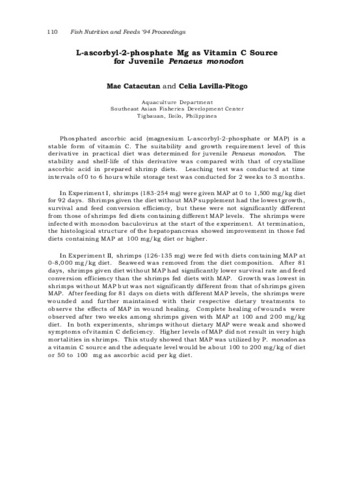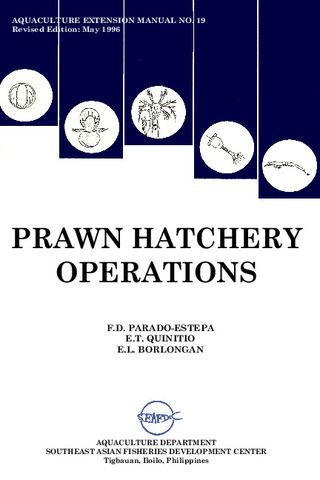L-ascorbyl-2-phosphate Mg as vitamin C source for juvenile Penaeus monodon
- Global styles
- MLA
- Vancouver
- Elsevier - Harvard
- APA
- Help

Date
1996Page views
5,095ASFA keyword
AGROVOC keyword
Taxonomic term
Metadata
Perlihat publikasi penuhShare
Abstract
Phosphated ascorbic acid (magnesium L-ascorbyl-2-phosphate or MAP) is a stable form of vitamin C. The suitability and growth requirement level of this derivative in practical diet was determined for juvenile Penaeus monodon. The stability and shelf-life of this derivative was compared with that of crystalline ascorbic acid in prepared shrimp diets. Leaching test was conducted at time intervals of 0 to 6 hours while storage test was conducted for 2 weeks to 3 months.In Experiment I, shrimps (183-254 mg) were given MAP at 0 to 1,500 mg/kg diet for 92 days. Shrimps given the diet without MAP supplement had the lowest growth, survival and feed conversion efficiency, but these were not significantly different from those of shrimps fed diets containing different MAP levels. The shrimps were infected with monodon baculovirus at the start of the experiment. At termination, the histological structure of the hepatopancreas showed improvement in those fed diets containing MAP at 100 mg/kg diet or higher.In Experiment II, shrimps (126-135 mg) were fed with diets containing MAP at 0-8,000 mg/kg diet. Seaweed was removed from the diet composition. After 81 days, shrimps given diet without MAP had significantly lower survival rate and feed conversion efficiency than the shrimps fed diets with MAP. Growth was lowest in shrimps without MAP but was not significantly different from that of shrimps given MAP. After feeding for 81 days on diets with different MAP levels, the shrimps were wounded and further maintained with their respective dietary treatments to observe the effects of MAP in wound healing. Complete healing of wounds were observed after two weeks among shrimps given with MAP at 100 and 200 mg/kg diet. In both experiments, shrimps without dietary MAP were weak and showed symptoms of vitamin C deficiency. Higher levels of MAP did not result in very high mortalities in shrimps. This study showed that MAP was utilized by P. monodon as a vitamin C source and the adequate level would be about 100 to 200 mg/kg of diet or 50 to 100 mg as ascorbic acid per kg diet.
Description
Abstract only
Type
Conference paperKoleksi
Related items
Showing items related by title, author, creator and subject.
-
An overview of the nutrition, feed and feeding techniques of prawn penaeid/shrimps
Piedad-Pascual, Felicitas (Philippine Council for Aquatic and Marine Research and Development, 1989)This paper echoes what transpired during the first International Conference of Penaeid Prawns/Shrimps held in Iloilo City in December 4-7, 1984, particularly on the Nutrition nd Feed Development. Around 25 papers were ... -
Series: Aquaculture extension manual; No. 19
Prawn hatchery operations
Parado-Estepa, Fe D.; Quinitio, Emilia T. ; Borlongan, Emeterio L. (Aquaculture Department, Southeast Asian Fisheries Development Center, 1996-05)
The manual, an updated version of the 1984 SEAFDEC/AQD manual, presents the underlying principles and step-by-step instructions of prawn larval and post-larval rearing. The techniques described are not only applicable to ...
; Borlongan, Emeterio L. (Aquaculture Department, Southeast Asian Fisheries Development Center, 1996-05)
The manual, an updated version of the 1984 SEAFDEC/AQD manual, presents the underlying principles and step-by-step instructions of prawn larval and post-larval rearing. The techniques described are not only applicable to ... -
The lowdown on world shrimp culture - II
Yap, Wilfredo G. (INFOFISH, 2001)This paper introduces some new members of the international shrimp culture club and goes on to discuss some recent technological innovations in the industry, particularly the polyculture of tilapia (mainly Oreochromis ...






